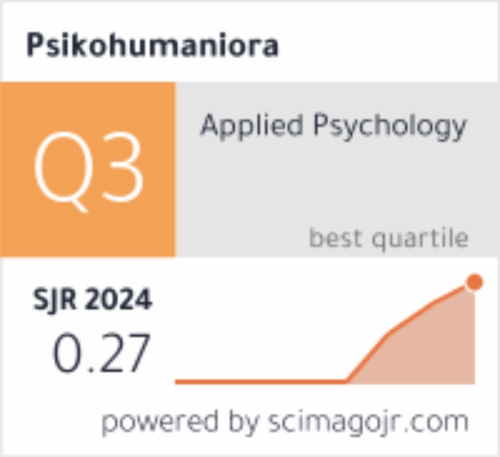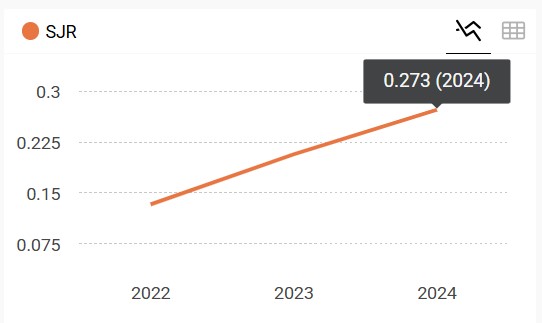Gambaran Ketangguhan Ibu dalam Mengasuh Anak Autis
DOI:
https://doi.org/10.21580/pjpp.v1i1.929Keywords:
children with autism, mother, hardinessAbstract
Abstract: This study aimed to look at the profile picture of hardiness in mothers of children with autism in the city of Medan. A total of 58 mothers were included in this study. Sampling was done by purposive sampling. The method was used to descriptive quantitative method. Data were taken using a measuring instrument such as Hardiness scale (Dispositional Resilience Scale/DRS-15). Processing and analysis of statistical data was descriptive, meaning that findings such as demographic data, aspects of hardiness and other additional data will be analyzed in the form of a minimum score, maximum score, mean and standard deviation, in order to illustrate the hardiness profile comprehensively. The results showed that the picture of the strength of the mothers of children with autism in average level. Judging from the hardiness, found that aspects of the commitments had the highest mean score, followed by the control aspect and the aspect of the challenge.
Abstrak: Penelitian ini bertujuan untuk melihat gambaran profil ketangguhan pada ibu yang memiliki anak autis di kota Medan. Sebanyak 58 ibu-ibu dilibatkan dalam penelitian ini. Pengambilan sampel dilakukan dengan purposive sampling. Metode yang digunakan adalah metode kuantitatif deskriptif. Data diambil dengan menggunakan alat ukur berupa skala Ketangguhan (Dispositional Resilience Scale/DRS-15). Cara pengolahan dan analisa data statistik bersifat deskriptif, artinya temuan seperti data demografi, aspek ketangguhan dan data tambahan lainnya akan dianalisa berupa skor minimum, skor maksimum, mean dan standar deviasi, agar dapat menggambarkan profil ketangguhan secara komprehensif. Hasil penelitian menunjukkan bahwa gambaran ketangguhan pada ibu yang memiliki anak autis berada dalam kategori sedang. Ditinjau dari aspek ketangguhan yang dikemukakan oleh Maddi & Kobasha (1980), ditemukan bahwa aspek komitmen memiliki nilai mean tertinggi, kemudian diikuti dengan aspek kontrol dan aspek tantangan. Implikasi penelitian ini sebagai data awal untuk melihat gambaran profil ketangguhan ibu dalam mengasuh anak autis di kota Medan.
Kata kunci: anak autis; ibu; ketangguhan
Downloads
References
American Psychiatric Association. (2014). Diagnostic and statistical manual of mental disorders, 5th edition. Washington, DC: Author
Ambarini, T. K. (2013). Hubungan antara hardiness dengan tingkat stres pengasuhan pada ibu dengan anak autis. Jurnal Psikologi Klinis dan Kesehatan Mental. 02(2), 34-40.
Ahmad. (2015). Kecerdasan emosional dan hardiness pada ibu rumah tangga single parent. Psikologika. Jurnal Pemikiran dan Penelitian Psikologi, 20(1).
Azwar, S. (2012). Metode penelitian. Yogyakarta: Pustaka Pelajar.
Bartone, P.T., (1991). Development and validation of a short hardiness scale. Paper presented at the Third Annual Convention of the American Psychological Society, Washington, DC.
Bartone, P.T. (1995). A short hardiness scale. Paper presented at the meeting of American Psychological Society. New York: NY
Baird, G., Simonoff, E., Pickles, A. (2006). Prevalence of disorders of the autism spectrum in a population cohort of children in South Thames: the Special Needs and Autism Project (SNAP). The Lancet, 368 (9531): 210-254.
Billing, A. G., & Moos, R. H. (1984). Coping, stres & social resources among adults with unipolar depression. Journal of Personality and Social Psychology, 46(4), 877-891.
Bolte, S., Westerwald, E., & Holtman, M. (2011). Autistic traits and autism spectrum disorders; the clinical validity of two measures presuming a continuum of social communication skills. Journal of Autism and Developmental Disorders 41(1): 66-72.
Center for Disease Control and Prevention. (2014). Prevalence of autism spectrum disoders- autism and developmental disabilities monitoring network, 14 sites, United States, 2008. Morbility and Mortality Weekly Report, 61, 1-9.
Compton, W. C., Seeman, J., & Norris, R. C. (1991). Predicting hardiness: A search for the parameters of deep cognitive structures. Medical Psychotherapy, 4, 121-130.
Dale, E., Johada, A., & Knott, F. (2006). Mothers attributions following their child’s diagnosis of autistic spectrum disorder. Autism, 10(5), 463-479.
Endraswara, S. (2012). Falsafah hidup Jawa: Menggali mutiara kebijakan dari intisari Filsafat Kejawen. Yogyakarta: Cakrawala.
Estes, A., Munson, J., Dawson, G., Koehler, E., Zhou, X. H., Abbot, R. (2009). Parenting stress and psychological functioning among mothers of preschool children with autism and developmental delay. Autism. 13 (4): 473-387.
Fombonne, E. (2005). Epidemiology of autistic disorder and other pervasive developmental disorders. Journal of Clinical Psychiatry 66 (Suppl. 10): 3–8.
Gable, R., Wolf, M., & Keilty, J., (1993). Instrument development in the affective domain (2nd Edition). Springer Science+Business Media, LLC. ISBN 978-94-011-1400-4 (eBook). http://doi 10.1007/978-94-011-1400-4
Gentry, W. D., & Oullette-Kobasa, S. C. (1984). Social and psychological resoucers mediating stress-illness relationships in humans. In W. D. Gentry (Ed). Handbook of behavioral medicine (pp.87-116). New York: Guilford.
Gray, D. E. (1994). Coping with autism: Stressess and strategies. Sociology of Health and Illness, 16 (3), 275-300.
Hattier, M. A., & Matson, J. L. (2012) An examination of the relationship between communication and socialization deficits in children with autism and PDD-NOS. Research in Autism Spectrum Disorders, 6(2), 871-880.
Holzer, L., Mihailescu, R., Rodrigues-Degaeff, C., Junier, L., Muller-Nix, C., Halfon, O., & Ansermet, F. (2006). Community introduction of practice parameters for autistic spectrum disorders: Advancing early recognition. Journal of Autism and Developmental Disorders, 36 (2), 249-262.
Judkins, S. K. (2001). Hardiness, stress, and coping strategies among mid level nurse managers: Implications for continuing higher education. Dissertation. Proquest.MI 48106-1346
Krissy, A. R., Tomas, D., Kushki, A., Duerden, E., Taylor, M., Lerch, J., Soorya, L., Wang, T., Fan, J., & Anagnostou, E., (2012). The effect of diagnosis, age, and symptom severity on cortical surface area in the cingulate cortex and insula in autism spectrum disorders. Journal of Child Neurology 28(6), 732-739. http//.doi.org.10.1177/ 0883073812451496.
Kristine M. Kulage., Arlene M. Smaldone., & Elizabeth G. Cohn. (2014). How will DSM 5 afect autism diagnosis? A systematic literature review and meta-analysis. Journal Autism Dev Disorder 44; 1918-1932. http//.doi.org.10.1007/s10803-014-2065-2
Kobasa, S. C. (1979). Stressful life events, personality, and health: An inquiry into hardiness. Journal of Personality and Social Psychology. 37, 1-11.
Kobasa, S. (1982). Commitment and coping in stress resistance among lawyers. Journal of Personality and Social Psychology, 42, 707-717.
Kobasa, S. C., Maddi, S. R., & Kahn, S. (1982). Hardiness and health: A Prospective study. Journal of Personality and Social Psychology, 42, 168-177.
Kobasa, S. C., Maddi, S. R., Pucceti, M. C., & Zola, M. A. (1994). Effectiveness of hardiness, exercise and social support as resources against illness. In A. Steptoe & J. Wardle (Eds), Psychosocial processes and health: A reader (pp.247-260). Cambridge: Cambridge University Press.
Koentjaraningrat. (1990). Pengantar ilmu antropologi. Jakarta: Rineka Cipta.
Maddi, S. R. (2006). Hardiness: The courage to be resilient. I Thomas, J. C., Segal, D. L., Comprehensive Handbook of Personality and Psychopathology: Personality and Everyday Functioning, 1, 306-321. New York. John Wiley and Sons. Inc.
Maddy, S. R. & Kobasa, S. C. (1984). The hardy executive, health under stress. Illinois: Dow Jones Irwin.
Martiarini, N. (2012). Pengatasan kelelahan ego (ego depletion) pada individu dalam konteks Budaya Jawa. (Tesis tidak dipublikasikan). Fakultas Psikologi, Universitas Gadjah Mada, Yogyakarta.
Matson, J. L., Hess, J., Neal, D., Mahan, S., & Fodstad, J. C. (2010). Trend of symptoms in children diagnosed with autistic disorder as measured by the Autism Spectrum Disorder-Diagnostic for Children (ASD-DC). Journal of Developmental and Physical Disabilities, 22 (1), 47-56.
Matson, J. L., Kozlowski, A. M., Hattier, M. A., Horovitz, M., & Sipes, M. (2012). DSM IV vs DSM V diagnostic criteria for toddlers with autism. Developmental Neurorehabilitation, 15(3), 185-190.
Maulana, M. (2014). Anak autis. Mendidik anak autis dan gangguan mental lain menuju anak cerdas dan sehat. Yogyakarta: Katahati.
Moore, A. (2010). Jenis kelainan pada anak. Jogjakarta: Kalamboti
Rahmah, A. (2012). Gambaran pola asuh ibu Suku Batak pada anak laki-aki dengan gangguan autis. Skripsi tidak dipublikasikan, Fakultas Psikologi, Universitas Sumatera Utara, Medan.
Santrock, J. W. (2002). Perkembangan masa hidup. Revisi 5. Jilid II. Jakarta: Erlangga.
Sastry, A., & Aguirre, B. (2012). Parenting your child with Autism. Practical Solutions, strategies, and advice for helping your family. Oakland: New Harbinger Publications, Inc.
Sitorus, M. C., (2016). Gambaran stres pada ibu yang memiliki anak autis. Skripsi tidak dipublikasikan, Fakultas Psikologi, Universitas Sumatera Utara, Medan.
Stefani. (2012). Hubungan kejadian penyakit autistik pada anak dengan usia maternal dan paternal di Kota Medan. Diunduh dari: http://repository.usu.ac.id/handle/123456789/31119/ tanggal 1 Oktober 2016
Strutton, D., Pelton, L. E., & Lumpkin, J. R. (1995). Personality characteristic and sales people’s choice of coping strategies. Journal of the academy of marketing science. 23 (3). 132-140.
Taylor, S. T. (1995). Health psychology. 3rd Ed. New York: McGraww-Hill, Inc.
Volkmar, F., Siegel, M., Woodbury-Smith, M., King, B., McCracken, J., & State, M. (2014). Practice parameter for the assessment and treatment of children and adolescents with autism spectrum disorder. Journal of the American Academy of Child and Adolescent Psychiatry, 53 (2), 237-257.
Weiss, M,J., (2002). Hardiness and social support as predictors of stress in mothers of typical children, children with autism, and children with mental retardation. Autism, 6 (1) 115-130; 021327 1362-3613 9200203) 6:1.
Downloads
Published
How to Cite
Issue
Section
License
The copyright of the accepted article shall be assigned to the publisher of the journal. The intended copyright includes the right to publish the article in various forms (including reprints). The journal maintains the publishing rights to published articles.
In line with the license, authors and any users (readers and other researchers) are allowed to share and adapt the material only for non-commercial purposes. In addition, the material must be given appropriate credit, provided with a link to the license, and indicated if changes were made. If authors remix, transform, or build upon the material, authors must distribute their contributions under the same license as the original.




